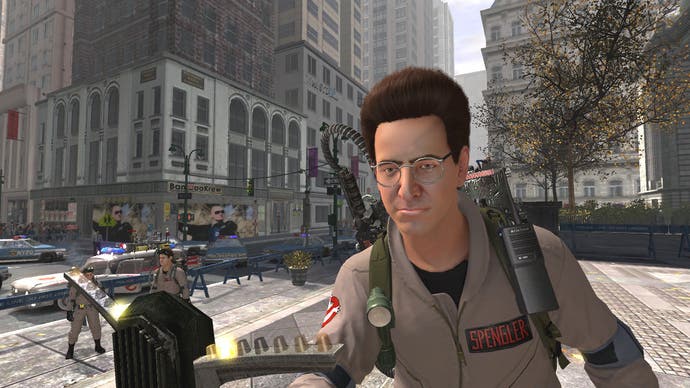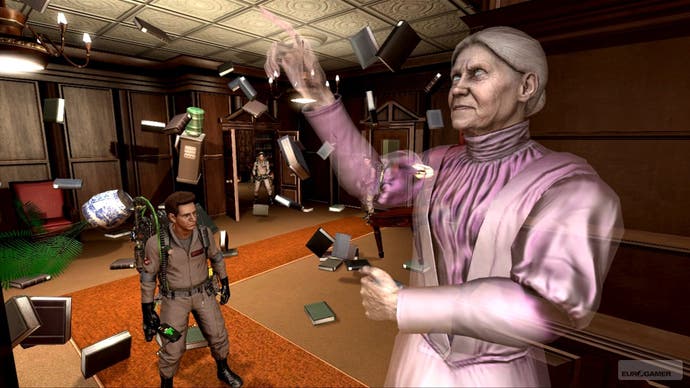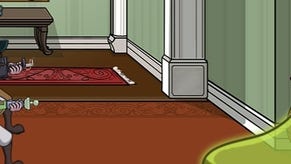Ghostbusters: The Videogame
Crossing the revenue streams.
Ivan Petrovich Pavlov and Ray Parker Jr. have more in common than you might think. True, one is a Nobel prize-winning Soviet physiologist and psychologist, while the other is an African-American singer-songwriter whose albums include Sex and the Single Man. One is best known for authoring Conditioned Reflexes: An Investigation of the Physiological Activity of the Cerebral Cortex; the other produced Sweat (Till You Get Wet). Pavlov has never been openly accused of nicking ideas off Huey Lewis, and Ray Parker Jr. has never had a ballerina or a pudding named after him.
But they both based their most famous work around one simple principle: you can create reactions in individuals by teaching them to associate specific stimuli with certain experiences. Pavlov discovered he could ring a bell to herald Winalot time and his doggies would start slobbering. Parker Jr. learned he could make people excited and happy just by getting a computer to go, "Nerny ner-ner ner-ner, nerny-nerny ner-ner-ner."
Even now, 25 years on, it's impossible for anyone over 30 to hear the nerny-ners without feeling nostalgic. Terminal Reality, the studio behind Ghostbusters: The Videogame, knows this, as does Vivendi / Activision / Atari / Sony / Oxford University Press or whoever is publishing it by the time you read this. They understand the power of memory, which is why the theme song features heavily in the trailers and throughout the game. It also explains why the opening cut-scene begins with the classic 1980s Columbia Pictures ident. Ahh, everything's going to be all right. Count Duckula pasta shapes on Mighty White for tea, washed down with a can of Quatro, let's hope the Soviets don't unleash global nuclear holocaust before Terrahawks starts.
See how easy it is to get carried away? And of all Ye Olde Intellectual Propertyes of Yesteryear, Ghostbusters is one of the most powerful. It was a funny, exciting, original movie with cross-generational appeal, starring Sigourney Weaver in a dress that slithered off her shoulders like molten bronze and Bill Murray as Bill Murray. Plus it had a theme tune that went "Nerny ner-ner ner-ner, nerny-nerny ner-ner-ner."

The second film was mediocre bordering on rubbish, but Ghostbusters remains a recognisable and much-loved brand today. The new videogame was originally touted as "the third Ghostbusters movie", until Dan Aykroyd took the shine off by announcing he was making an actual third movie. There was also much talk about how Aykroyd had written the entire script, until he revealed Terminal Reality did two-thirds of it.
They've done a good job, though. There are some great jokes in Ghostbusters: The Videogame, delivered with impeccable timing by the proper actors. The script is generally in-keeping with the style of the movies; Winston Zeddemore has less to do than the other characters, for example, and fewer one-liners. (Odd, considering Bill Murray is said to have only agreed to do a voiceover if Zeddemore's character got full status. Or perhaps not so much, considering Aykroyd recently said the film's success was half down to Murray and half down to himself, Weaver, Ivan Reitman, Rick Moranis and Harold Ramis. What about Ernie?)
The plot is a familiar mishmash of scientific nonsense, mythological hokum and hot chicks pretending they don't want a go on Bill Murray. It's set two years after the events of Ghostbusters 2, when spooks are running riot in Manhattan once again. You play as a new recruit hired to help out the fab four and test their latest equipment. There are new baddies to take on along with old friends such as Slimer, the library ghost and the marshmallow man. Recognisable locations include the New York Public Library and the Sedgewick Hotel.

There's an impressive amount of detail to the environments; you can go up to the noticeboard in the Fire Station and read individual documents, for example, or check out the display notes in the museum. The textures are realistic and the lighting is generally excellent - though some dark corridors are a bit too dark, to the point where it's easy to get disorientated. There's an impressive number of curling wires and blinking lights on the Ghostbusters' proton packs and characters look just like their real-life counterparts; you can see those tiny scars on Venkman's cheeks and Egon's hair is perfectly bouffed (not blonde, Real Ghostbusters haters will be pleased to hear). It's a shame the illusion is broken when characters start talking. This is the kind of lip-synching our grandchildren will laugh at, in the same way we snigger at laser discs and stamps.
It's also a shame the level layouts are so painfully linear and scripted. The Ghostbusters may look real enough and deliver some decent wisecracks, but they also spend a great deal of time standing round as silent, aimless automatons. You realise they're waiting for you to do something, either lead the way towards the next part of the level or trip some invisible environmental switch to trigger the next event. The game tricks you into feeling you have freedom to make choices and go exploring, when really you're just following a strictly preset path.
For instance, there's a point in the first Sedgewick Hotel level when Egon announces he and Ray are heading upstairs. He instructs you to follow Venkman. If you ignore this and pursue Egon and Ray you'll find them standing silent and motionless by a lift, like robots whose batteries have run out. They'll happily stay there all day. Give up and go after Venkman and you'll find him waiting patiently and silently too. Try to ignore the lot of them and follow your own path, and you'll just come up against dead ends and locked doors.
There's an even more tedious section later on in the level where you're on your own, stalking a fisherman ghost through hotel corridors. The corridors are too dark and all look the same, and there are no clues as to where you're supposed to go next. You end up trudging aimlessly around, hoping the next turn you take will be the one that triggers the ghost's reappearance.



